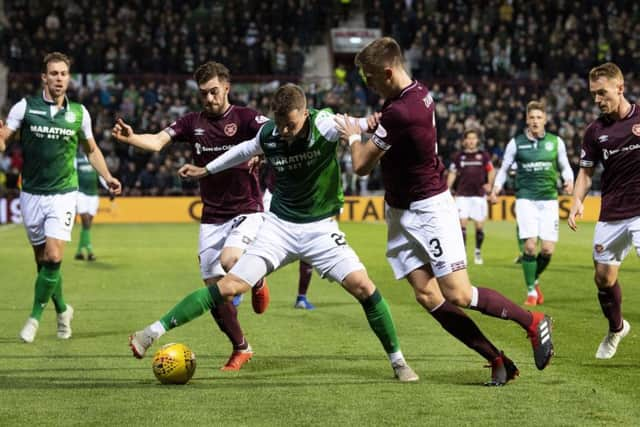Analysis: Why have the goals dried up for Hearts and Hibs?
This article contains affiliate links. We may earn a small commission on items purchased through this article, but that does not affect our editorial judgement.
and live on Freeview channel 276
Frustration has been the central feeling around Hearts and Hibs lately. Neither side have won in their last four outings, with a goalless draw in the Edinburgh derby the only thing to show for their efforts.
Advertisement
Hide AdAdvertisement
Hide AdIt’s in stark contrast to the opening months of the season. Both teams showcased their promise in front of goal as Hibs hit six twice in Europa League qualifiers, while Hearts netted five on two occasions in the Betfred Cup.


Craig Levein’s Hearts averaged 2.19 goals per game across their first 16 fixtures, while Neil Lennon had seen his side rack up an average of 2.35 goals per game in their first 17 matches. Of those combined 33 games, only three times did either side fail to net.
Hibs have now gone 287 minutes without finding the back of the net. As for Hearts, it’s 407 minutes.
At Easter Road, fans were right to be delighted when they managed to re-sign both Flo Kamberi and Jamie Maclaren. The duo had struck up an excellent partnership during their loan spell last season, scoring 17 goals between them. They worked perfectly together. Kamberi the link man, dragging defences all over the place with his all-action style and Maclaren the penalty box striker with shrewd movement.
Advertisement
Hide AdAdvertisement
Hide AdThey have not been able to rekindle their flourishing relationship. Friday’s 1-0 defeat at Aberdeen was only the second time they had started in attack together this season and the first time since the 3-0 defeat to Molde in the Europa League. Lennon has largely preferred a front two during his time at Hibs. It has meant that more has been required of Oli Shaw than was perhaps envisaged, while Lewis Allan is still raw. The Hibs boss has even used Martin Boyle as a striker.
The mixture of injuries and suspensions have prevented Lennon from getting a consistency of selection - across all areas of the park. It can be argued that Lennon has not had his best XI available this season, forcing him to chop-and-change systems and personnel.
It has seen the likes of Boyle struggle to regain the scintillating form of earlier in the season, while Stevie Mallan’s consistency at finding the back of the net from distance is not something which realistically could continue.
There were strong calls for Scott Allan to be brought back in January after the Aberdeen defeat. Understandable considering he is a creative force when he pulls on the Hibs jersey. Fans of all clubs are good at jumping to conclusions but the positivity after the 6-0 thrashing of Hamilton shouldn’t be forgotten, with a midfield of Mallan, Mark Milligan and Emerson Hyndman. That being said, there may be something in it, in terms of the quality of chances created.
Advertisement
Hide AdAdvertisement
Hide AdOn average, per 90 minutes, shots, crosses, touches in the box and passes into the final third have increased in the league this season for Hibs. Tellingly, however, the percentage of shots hitting the target has fallen from 35.19 per cent to 26.78 per cent.
On the other side of the Capital, the reason is quite obvious and straightforward. Injuries to Steven Naismith and Uche Ikpeazu have hampered Hearts. Of the 19 league goals, the injured duo have been involved in 13, whether that be a goal or an assist.
It was clear to see early on in the season how much more of an attacking threat Hearts were in comparison to the previous campaign. The trio of Steven MacLean, Naismith and Ikpeazu worked so well that it was hard for Levein to leave any of them out.
Advertisement
Hide AdAdvertisement
Hide AdIt saw the progression of the lop-sided 4-4-2 system with Naismith supporting the attacking duo from the left. But in essence, Levein trusted the experienced and intelligent forward to flit around as he saw fit. Hearts had a real balance and variety of attacking qualities and crucially legs to support MacLean.
Ikpeazu’s injury was a huge blow but the team coped admirably, with Naismith performing so well. Then the Scotland internationalist went down in the Betfred Cup semi-final against Celtic. The adage that you don’t know what you’ve got till it’s gone certainly rings true with Hearts fans and Naismith.
It’s been a difficult adaptation since his injury. It was hard enough to try and make up for Ikpeazu’s absence but add Naismith into the equation and any manager, no matter the level, would struggle to replicate the duo’s qualities.
Levein has spoken of the obvious difficulties in trying to do so. The Hearts boss is having to ask younger players to step into the void. Both Craig Wighton and Sean Clare are still getting up peak fitness, while Jake Mulraney and Danny Amankwaa are raw wingers.
Advertisement
Hide AdAdvertisement
Hide AdIt increases the reliance on MacLean, who has cut a more frustrated figure without his striker partners, who understand and complement his game so well.
Entering the final international break of the year it is unlikely to be a huge concern for Lennon and Levein who have both seen their side create chances in recent fixtures.
Both sides are presented with appealing games after the break with Hibs facing bottom side Dundee and Hearts travelling to second-bottom St Mirren. Failure to score in those games, however, and alarm bells may start ringing.
Join our Facebook group Our Edinburgh to share images and news from and around the Capital